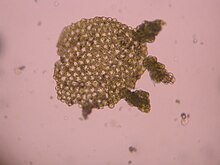
Asexual reproduction is a type of reproduction that does not involve the fusion of gametes or change in the number of chromosomes. The offspring that arise by asexual reproduction from either unicellular or multicellular organisms inherit the full set of genes of their single parent and thus the newly created individual is genetically and physically similar to the parent or an exact clone of the parent. Asexual reproduction is the primary form of reproduction for single-celled organisms such as archaea and bacteria. Many eukaryotic organisms including plants, animals, and fungi can also reproduce asexually.[1] In vertebrates, the most common form of asexual reproduction is parthenogenesis, which is typically used as an alternative to sexual reproduction in times when reproductive opportunities are limited. Some monitor lizards, including Komodo dragons, can reproduce asexually.[2]
While all prokaryotes reproduce without the formation and fusion of gametes, mechanisms for lateral gene transfer such as conjugation, transformation and transduction can be likened to sexual reproduction in the sense of genetic recombination in meiosis.[3][4]
- ^ Engelstädter, Jan (June 2017). "Asexual but Not Clonal: Evolutionary Processes in Automictic Populations". Genetics. 206 (2): 993–1009. doi:10.1534/genetics.116.196873. PMC 5499200. PMID 28381586.
- ^ Dudgeon, Christine L.; Coulton, Laura; Bone, Ren; Ovenden, Jennifer R.; Thomas, Severine (16 January 2017). "Switch from sexual to parthenogenetic reproduction in a zebra shark". Scientific Reports. 7 (1): 40537. Bibcode:2017NatSR...740537D. doi:10.1038/srep40537. PMC 5238396. PMID 28091617.
- ^ Narra, H. P.; Ochman, H. (2006). "Of what use is sex to bacteria?". Current Biology. 16 (17): R705–710. Bibcode:2006CBio...16.R705N. doi:10.1016/j.cub.2006.08.024. PMID 16950097.
- ^ Bryner, Jeanna (20 December 2006). "Female Komodo Dragon Has Virgin Births". Live Science.